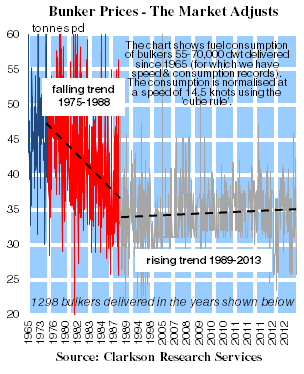The big issue (well, one of them) floating around the shipping market at the moment is the move to eco-ships. These technological marvels promise a step change in cost savings and environmental friendliness compared with their pre-crisis competitors. For example the latest Japanese Supramax offering does 14.5 knots on 28 tonnes per day. That sounds good, but how big a step up is that?
Thirsty Old Ladies?
The key is not so much out-performing modern ships; it's the thirsty old ladies that investors hope the new super-ships will drive from the market, accelerating the return to balance. But this depends on whether the eco-ships are really that much better than the old ladies. To find out we analysed 1298
bulkers of 55-70,000
 dwt
delivered between 1965 and 2013. Some have been scrapped, but they help
plot the long-term trend. To make the comparison more consistent, each
ship’s fuel consumption was adjusted to a standard 14.5 knots, using the
cube rule. The resulting bunker consumption for each ship is plotted
against its delivery date. The dates run from 1965 to 2013, and the
consumption levels range from below 25tpd to well over 60tpd.
dwt
delivered between 1965 and 2013. Some have been scrapped, but they help
plot the long-term trend. To make the comparison more consistent, each
ship’s fuel consumption was adjusted to a standard 14.5 knots, using the
cube rule. The resulting bunker consumption for each ship is plotted
against its delivery date. The dates run from 1965 to 2013, and the
consumption levels range from below 25tpd to well over 60tpd. Easy Pickings?
Back in the 1960s, when oil cost just $1.80/bbl and bunkers were only $17/tonne, ships were thirsty and getting thirstier. By 1973 the average consumption of a 60,000 dwt bulker was 49.3tpd. So when the oil price shot up to $10/bbl in 1973 and $40/bbl in 1979 improvement was essential and easily achievable. By 1987 consumption by new ships was down by one third to 35.5tpd at 14.5 knots. Then unexpectedly in 1986 oil prices slumped to $10/bbl and fuel economy was no longer such an issue. Consumption edged down to 33tpd in 1990, briefly touched 30.9tpd in 2005 as new Japanese Supramaxes came in, then shot back to 36 tpd in 2010 as top of the market Chinese-built ships were delivered.
The Bottom Line
These trends highlight three eco-ship issues. Firstly, the fuel consumption in the last 20 years was pretty flat and on paper at least, many of the modern ships are less efficient than older generations. Secondly the big improvement 1975-88 which started from $2/bbl gas guzzlers will be difficult to repeat because the technology has been squeezed so hard over the last 25 years. Thirdly the big fuel saver is slower speed and good old ships can play this game as well as new ships.
Bunker Bonus vs Big Balance Sheet
So there you have it. Most of the old fleet was built to operate in the 32-35tpd band, giving the 28tpd eco-ship a 15-20% advantage. But these new ships carry a lot of capital costs and in the long-term the return on capital counts, not who you beat at the loading point today. Against this background, and the many uncertainties over the true performance of the new eco-technology, it's no wonder investors are struggling. Eco-features are definitely a nice bonus if you need a new ship, but it's the need issue that's tricky.
Source: Clarksons
Post to be found at:
http://www.hellenicshippingnews.com/News.aspx?ElementId=fc1d5fe6-67ee-490c-8cb2-a2ba075fc619&utm_source=newsletter&utm_medium=email&utm_campaign=daily



 ShareThis
ShareThis
No comments:
Post a Comment